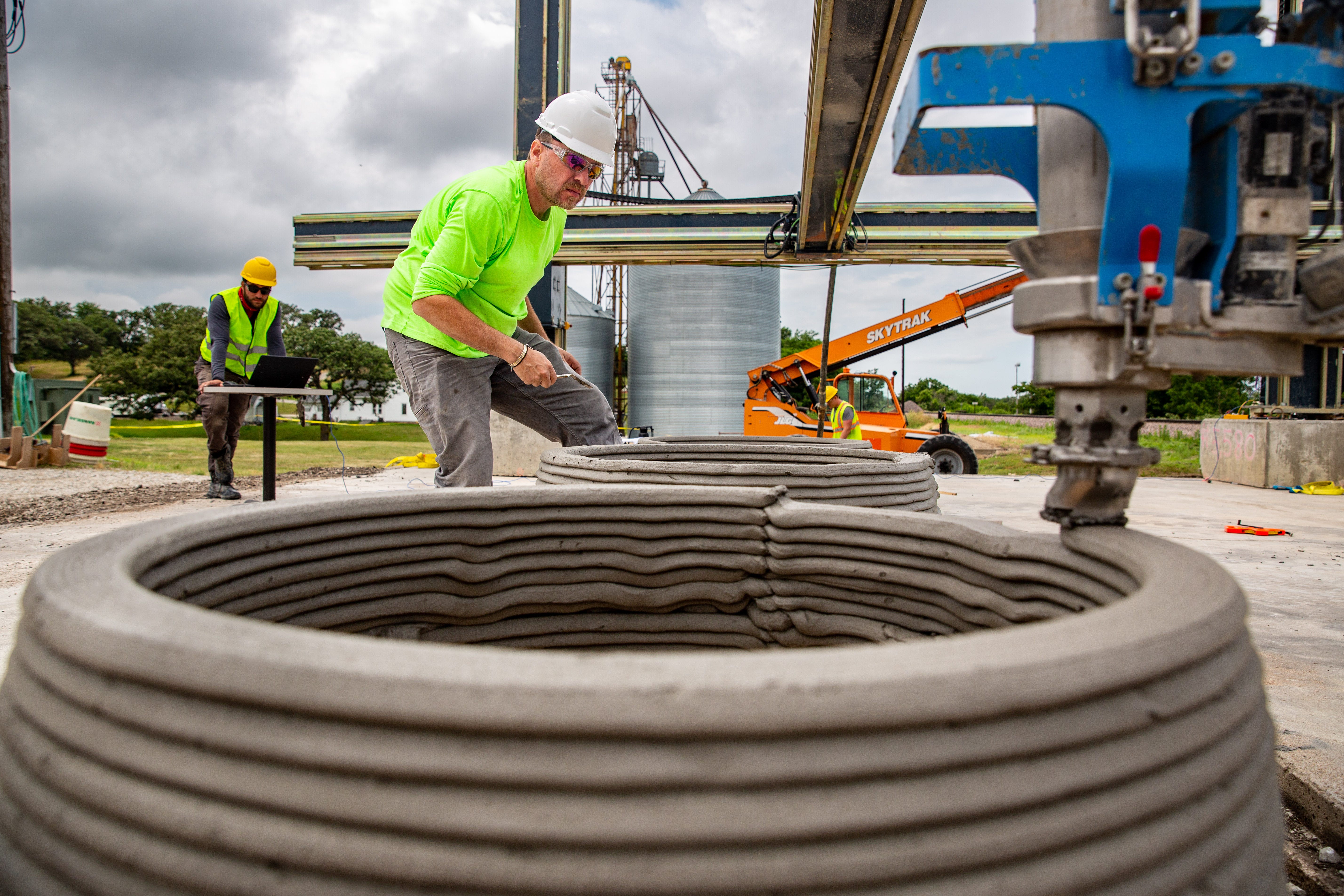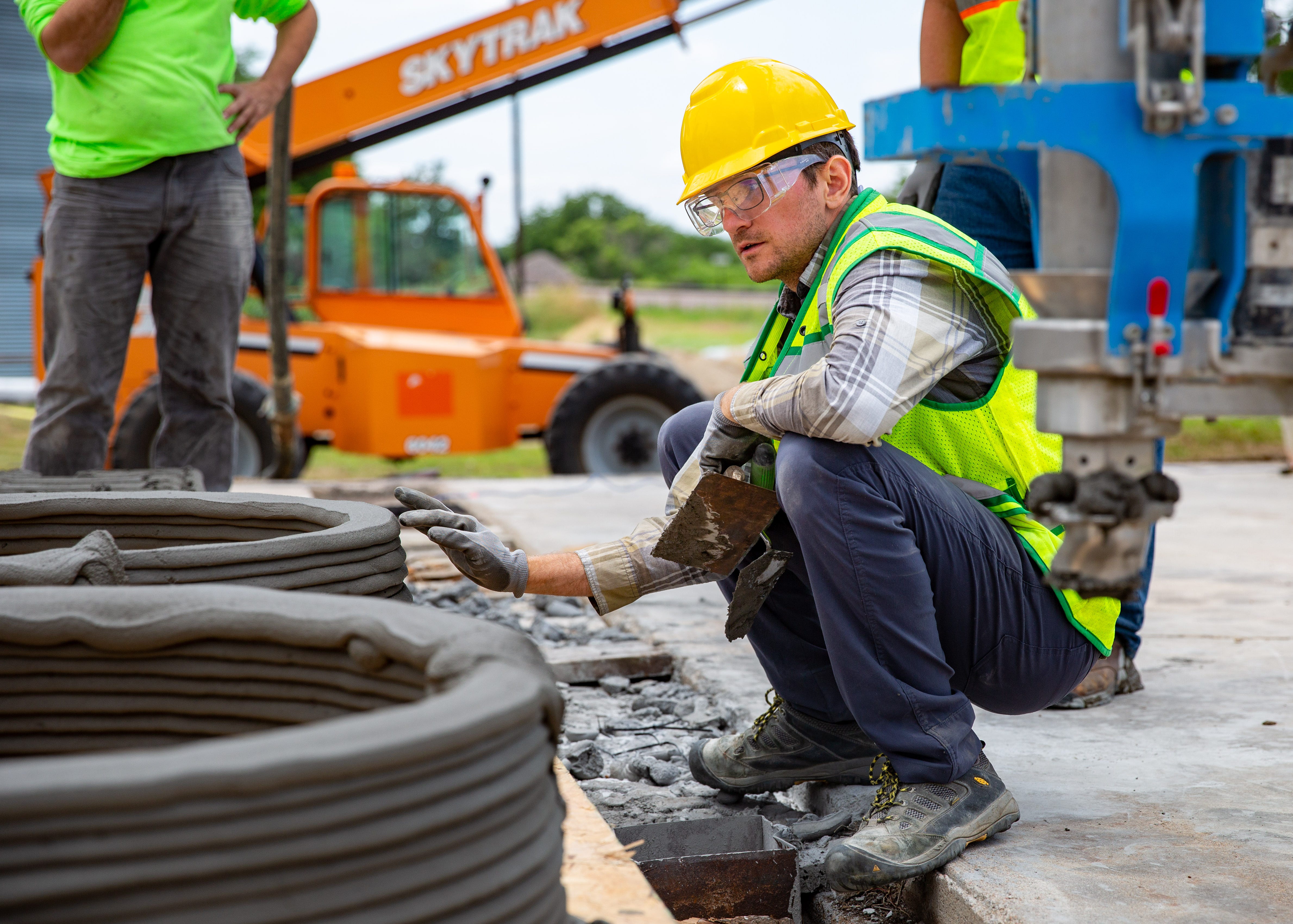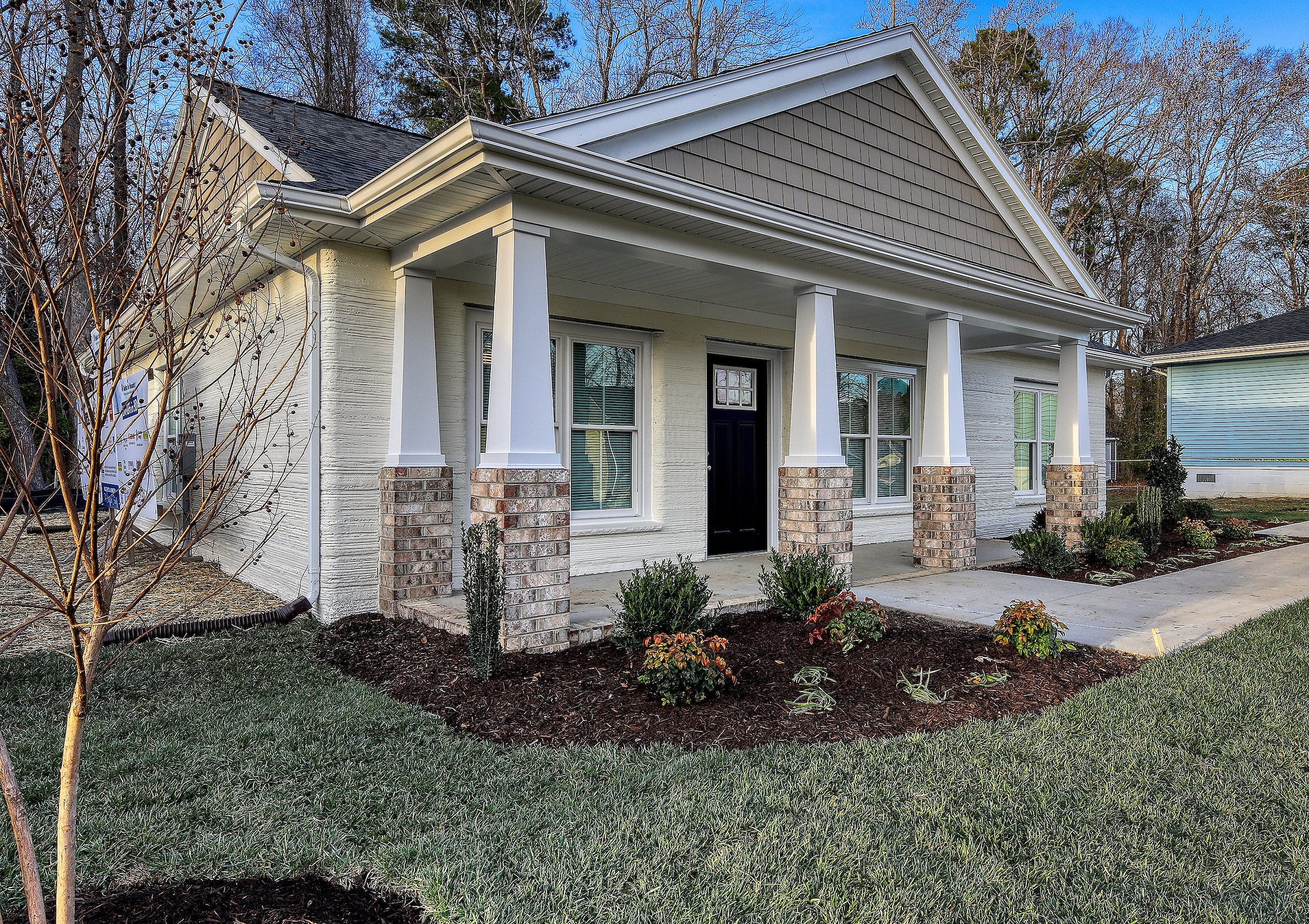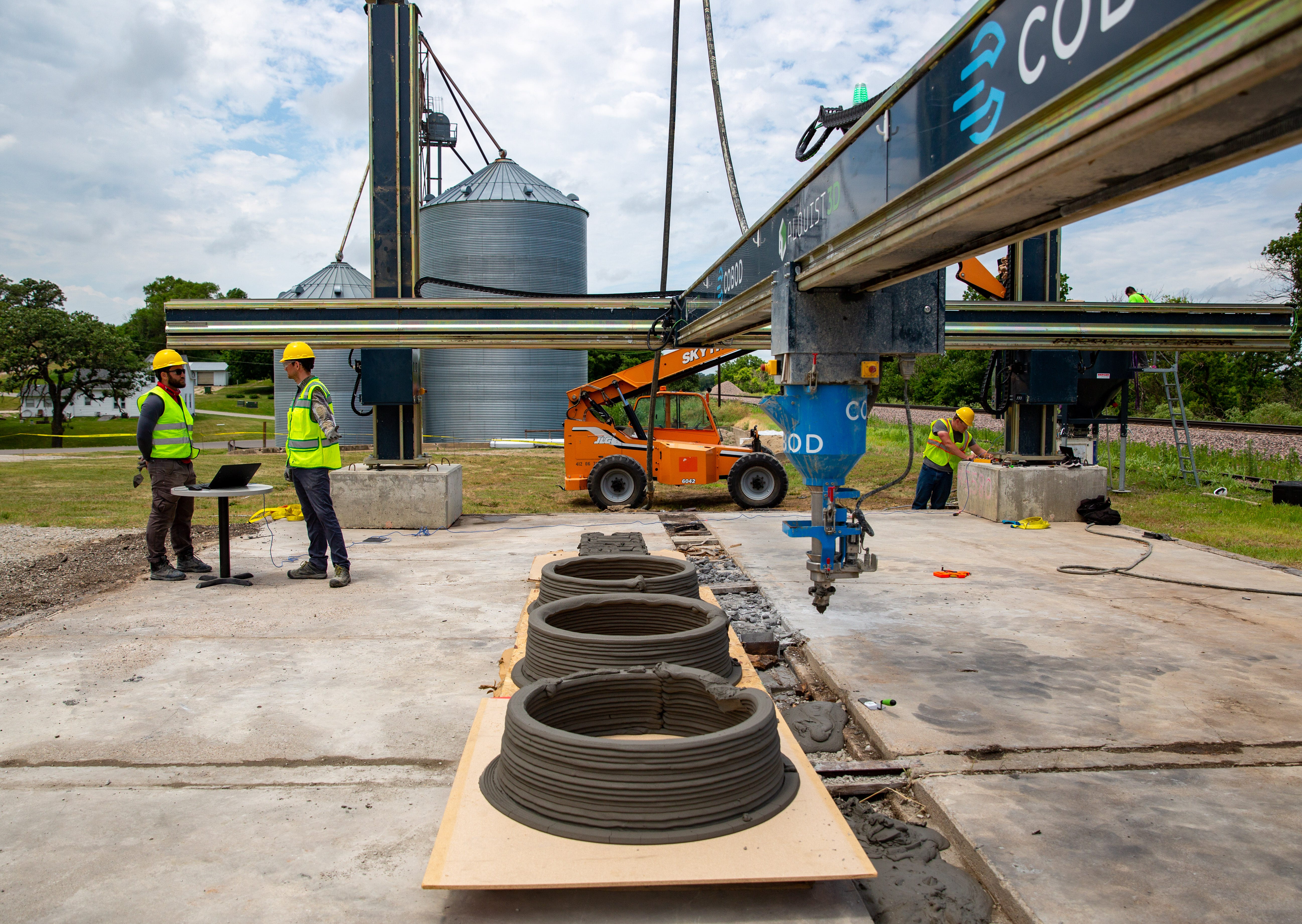Iowa-based Alquist hopes to ease housing crisis with 3D-printed homes - Des Moines Register
- Get link
- X
- Other Apps
STANTON — On an overcast day in June, a robotic nozzle spits out concrete like buttercream from a pipette.
Four workers watch to ensure the nozzle, suspended from a boom moving along a 40-foot-long track, hits its computer-programmed marks. It pipes a 3-foot circle of wet concrete, then another two just to the right. That process complete, the boom returns the nozzle to the first circle, where it pipes another layer.
Eventually, the layers reach 2 feet in height.

The massive 3D printer here is making vaults that will house junctions for fiber optic cables underground. But there's a larger goal: to train the workers to use a similar machine to make 3D-printed homes for Iowans.
Alquist 3D, an Iowa City-based company, plans to print 20 homes in southwest Iowa next year. It sees the technology as part of a solution to America's shortage of affordable housing and its climate change crisis. Using the computerized equipment is generally cheaper than standard construction, and the thick concrete is a good insulator, making the homes require very little energy to heat and cool, according to founder and CEO Zachary Mannheimer.
They also take less time and fewer workers to build, and Alquist sees them as a way to cope with the nation's housing and construction trades workforce shortages.
"The mission of Alquist is to solve the housing crisis of America. And not just at the affordable level but across the board — houses are needed across every spectrum," Mannheimer said.
Zach Boyden-Holmes/The Register
The U.S. is short about 6.8 million housing units, according to the National Association of Realtors, and a recent Iowa Economic Development Authority study found the state needs to add 47,000 new homes in the next decade to accommodate growth. At the same time, the nation has 65,000 open construction jobs and not enough skilled workers to fill them, according to new research by Stanley Black & Decker.
State leaders share Mannheimer's optimism about 3D printing. The IEDA last year awarded $1.4 million to the Iowa State University College of Design for the purchase of a 3D printer capable of producing concrete houses, with the goal of printing homes as part of a 40-unit development in Hamburg. The southwest Iowa town has struggled to replace housing lost in the 2019 Missouri River floods.
The college also will develop a curriculum for training contractors on 3D printing and propose new state building codes to "build an ecosystem" for this type of housing in Iowa, IEDA Executive Director Debi Durham told the board of the agency's Iowa Energy Center in May.
"Every time I see it, I get more excited," she said. "And I know that once the industry really starts seeing it, it's going to truly transform what we can do here."
Every time I see it, I get more excited. And I know that once the industry really starts seeing it, it's going to truly transform what we can do here.
While 3D printers have been used since the 1980s to make things like toys, furniture and even face shields for hospital workers during the height of the COVID-19 pandemic, employing the technology for homebuilding in the U.S. is very new.
As with the fiber optic vaults, the 3D printer creates layers of specialized concrete similar to the packaged concrete mix product Quikrete, mixed to work in the temperature and humidity levels for the site. Each layer follows the shape of the home's foundation, one lying atop the other until the walls reach from the ground to the roof.
The concrete takes the place of a traditionally built home's framing, siding and drywall. Tradespeople then install plumbing, electricity, heating, air conditioning and other mechanical systems, as well as doors and windows. The finished homes' unusual material can be emphasized with contemporary designs or muted through the use of traditional features.
The home's architectural drawing is produced using computer-assisted design, then transferred to software that determines each layer's height, the print speed and the path the printer will take, said Aiman Hussein, director of printing technologies for Alquist.
The printer can lay up to a 10-inch length of concrete per second, generating a 2-foot-thick layer on a good day, he said.
The structure of Alquist's first 3D-printed home, finished last year, took about 22 hours to print, said Hussein, who has amassed more than 60,000 followers on TikTok as @thelayerlord, posting videos that showcase the technology.
That home, built in collaboration with Habitat for Humanity Peninsula and Greater Williamsburg in Virginia, was the first owner-occupied 3D-printed home in the U.S., according to Alquist.
The company partnered with Virginia Tech to design the home, help navigate the code approval process and evaluate its cost and long-term performance using in-home sensors and monitors.
"A house has never been so studied," said Andrew McCoy, director of the Virginia Center for Housing Research and associate director of the Myers-Lawson School of Construction at Virginia Tech.
The project focused on designing a home so efficient that preliminary data shows it could cost the homeowner as little as $30 per month in energy bills.
Early data also shows the home in Williamsburg was built for about $165 per square foot — about the same cost as a traditional home. Virginia Tech believes 3D-printed homes could cost 8% to 10% less when mass produced, McCoy said.
Alquist hopes to build a 1,500-square-foot 3D-printed home for $215,000, down from the $237,000 it currently costs. It costs up to $271,000 for major Iowa homebuilder Hubbell Homes to build the same size home using traditional methods,
Building a neighborhood of 3D-printed homes would drive down the price by saving on one of the biggest costs: transporting the 40-by-40-foot printer by semi-truck to a job site, McCoy said.
"We've kind of hit that point where it's relatively even," he said. "(But) if you can do six houses at a time, then you're going to have economies of scale."

That's what Alquist hopes to do in Pulaski, Virginia, where it will print 200 homes with Black Buffalo 3D over the next three years. With plans for a Volvo truck plant, a medical glove manufacturing facility and other industrial employers, Pulaski expects to add 3,000 jobs over the next year, and leaders there see the efficiency of printing homes as a way to accommodate them.
"We know we've missed opportunities for people to move here because there weren't homes," said Kevin Cabbage, general manager and CEO of the Stanton-based Farmers Mutual Telephone Co. Cabbage is board chair of Alquist and an investor in the company. He led June's printing of fiber optic cable vaults, which his company hopes will help circumvent rising costs and supply chain shortages.
Before starting Alquist, Mannheimer was widely known in the Des Moines metro for founding the Des Moines Social Club in 2008. The nonprofit was dedicated to the arts and community building and in 2012 bought the historic art deco-styled Firehouse No. 1 at 900 Mulberry St. downtown.
The Social Club offered hundreds of community classes each month on topics such as dancing, cooking and writing and showcased local artists, theater and bands, all at modest prices so people of all income levels could participate. But it could not sustain its funding model, which relied on ticket sales and donations, and after Mannheimer left the organization, it fell into debt and dissolved in 2019.
Mannheimer next turned to community building through cultural and recreational activities in rural areas. He founded Atlas Community Studios, which works with rural communities across the U.S. to find creative ways to attract and retain workforce by addressing issues such as providing child care, broadband Internet and housing.
While a shortage of any of the three can stunt growth in small communities, providing housing has been by far the biggest challenge, he said.
Our goal always has been to create community. And you can't create community without housing.

"Our goal always has been to create community. And you can't create community without housing," Mannheimer said.
Alquist has plans to build on eight lots in New Market and up to three lots in Stanton. It's in conversations with leaders in Avoca and Red Oak, also in southwest Iowa, with the goal of reaching the scale of production needed to ensure affordability, Mannheimer said.
Iowa State University hopes to create its first prototype in Hamburg as early as this fall, Pete Evans, assistant professor of industrial design, told the Iowa Energy Center board in May.
And IEDA recently awarded Community Housing Solutions $10.4 million in Community Development Block Grant Disaster Recovery Housing funds to build 40 new homes in Malvern, also hit by flooding. Heath Paulsen, a partner, said the team is considering contracting with Alquist for 3D-printed homes, in part due to the materials delays and workforce shortages plaguing the homebuilding industry.
"With the time constraints (of the grant), we looked at (traditional construction) and we didn't think we'd get everything built in time," he said. "We looked at manufactured homes, but we didn't think they'd all be delivered on time."
"It just kind of leads to a new solution," Paulsen said.

Demand for 3D-printed homes has soared, said Mannheimer, whose company is fielding 25 to 50 requests per hour. But "with only five or six companies nationally doing this work," there is still a lot to learn about the emerging technology, he said.
"We know that we can deliver homes at slightly less … today when we're scaling. And the more that we're doing and the more experience we get, it's going to be able to be far lower in the next two years. So there's still a lot of experimentation," Mannheimer said.
"And there's still a ton we don't know, and a lot that we need to improve on, both from an experience standpoint and from a technology standpoint," he added.
ISU's mission, beyond printing homes, is to evaluate the technology and how it can best be applied in Iowa, Evans said. Companies and 3D-printing websites claim a 50% to 80% reduction in labor and materials costs and reductions in waste, he said, "and we really just need to understand this better to be able to deploy it here in the best and most appropriate way."
"One of the things our project is really trying to tackle is some claims that are out there to better understand and objectively realize these here in Iowa and understand what we should and should not do," Evans said.
I'm sure in Iowa our builders are going to hang on to traditional methods for as long as possible, but as technology advances I think there's outstanding opportunity.

And there's a question of how to ensure workers will have the knowledge to operate a large 3D printer.
Iowa State's program includes a partnership with Iowa Central Community College to train future workers in advanced home construction. And Alquist has partnered with Virginia Tech to bring training programs to community colleges and high schools in communities where the company is printing 50 or more homes.
Jay Iverson, executive officer of the Iowa Home Builders Association of Iowa, said he is not concerned about construction workers losing their jobs if 3D printing emerges as a popular concept. While the technology reduces the number of workers needed on site for framing, tradespeople still are needed to install the remainder of the home.
"We're so short in all of the trades right now. There's always going to be opportunity for people to be employed in the industry," said Iverson, calling 3D-printed housing "the way of the future."
Further research also is needed to find a more carbon-neutral product than concrete, Mannheimer said. Making concrete involves heating limestone and clay in a kiln, a process that both uses and releases greenhouse gases. Mannheimer's company is seeking grants to study the use of coal fly ash, recycled glass or plastic, and hemp.
Once the systems are in place, including code changes, trained workers and the possibility for lighter or more nimble printers, Mannheimer believes anyone wanting a 3D-printed home will be able to buy one anywhere in Iowa by 2024.
"There will be serious savings at that point," he said.
Kim Norvell covers growth and development for the Register. Reach her at knorvell@dmreg.com or 515-284-8259. Follow her on Twitter @KimNorvellDMR.
- Get link
- X
- Other Apps
Comments
Post a Comment